
How Illinois Can Raise Billions by Taxing Carried Interest
ACROSS THE COUNTRY, STATES LIKE ILLINOIS STAND TO GAIN BILLIONS OF DOLLARS IN REVENUE BY CLOSING THE CARRIED INTEREST LOOPHOLE.
Across the country, states like IL stand to gain billions by closing the carried interest loophole. Share on XIT’S A LONG OVERDUE ELEMENT OF FINANCIAL REFORM THAT THE FEDERAL GOVERNMENT HAS FAILED TO ENACT, DESPITE BIPARTISAN SUPPORT FOR TAX FAIRNESS.
In last year’s Presidential campaign, Donald Trump, Hillary Clinton, Bernie Sanders, and Jeb Bush all called for closing a tax break known as the “carried interest loophole,” a legal action used by private equity firms and other members of the wealthy elite to lower their federal tax rates below those paid by many working Americans.[1]
These financiers charge a fee for investing other peoples’ money – and call it “carried interest” to get a lower tax rate than kindergarten teachers and truck drivers.[2]
Presidential candidates in both parties, experts, advocates and everyday Americans all agree that Wall Street and LaSalle Street millionaires and billionaires should not get preferential treatment on their taxes.[3]
It’s unfair and wrong. Smart reform can bring this practice to an end.
Closing the loophole would save the federal government an estimated $18 billion per year, according to an analysis by law professor Victor Fleischer.[4]
But huge sums of lobbying and campaign cash directed at Congress by hedge funds and private equity firms have stymied reform in Washington and fueled continued obstructionism.
Hedge fund and private equity managers gave millions of dollars to PACs and Super PACs that kept Congress in the hands of conservative Republicans, buying in uence in this year’s tax policy discussions in Washington.[5]
And this same class of Wall Street billionaires are now taking high positions in the Trump cabinet and in regulatory agencies – in January Bloomberg said “private equity has the President-elect on speed dial,”[6] and predicted the new Trump Administration would not substantially close the lucrative loophole.
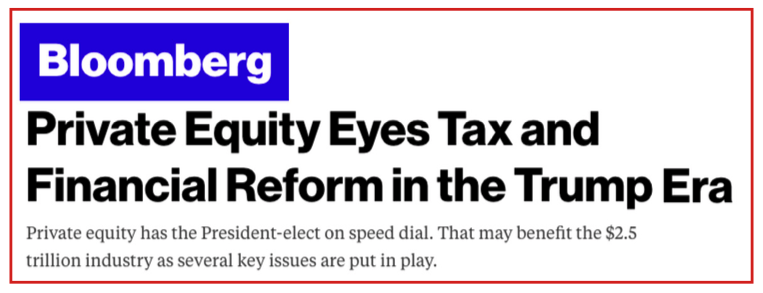
That’s why state action is crucial.
Across the country, legislatures can pass legislation to tax the carried interest income of private equity firms, hedge funds, and other financial entities headquartered in their respective states at the rate of ordinary income.
This report from Hedge Clippers uses hedge fund and private equity data from Preqin, to show that Illinois could raise huge sums of revenue by acting to close the carried interest loophole.
Using a conservative methodology for estimating the potential annual revenues, the analysis in this report reveals that state action on carried interest could recapture many billions of dollars across the country, with hundreds of millions or billions for each state.
In states like New York, Massachusetts, Illinois, Connecticut and California, the estimated income to be gained by taxing carried interest at the state level is enormous.

Illinois’s private equity and hedge funds are conservatively estimated to be earning $4.8 billion per year in under-taxed carried interest.
A state bill to recapture this revenue at the ordinary income level has strong sponsorship in both houses of the State Legislature, and it would raise at least $473 million each year for schools, health care and essential public services in Illinois.
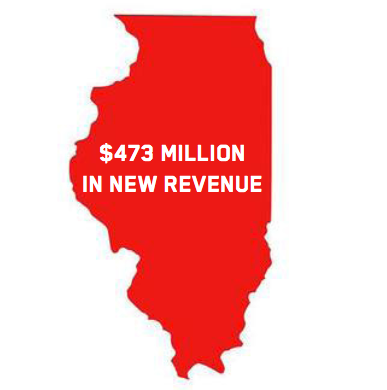
CARRIED INTEREST LOOPHOLE: UNFAIR TAX BREAK FOR BILLIONAIRE HEDGE FUND MANAGERS
What is the carried interest loophole?
Simply stated, the carried interest loophole is the mistreatment of hedge fund and private equity fees as capital gains, rather than ordinary income.
According to the New York Times,
Partners at private-equity firms and hedge funds typically treat a big portion of the fees they charge their clients as a capital gain — that is, as profit on the sale of an investment — so they can pay tax at the capital-gains rate of 20 percent (plus a surtax of 3.8 percent typically).
Ordinary income is taxed at a rate of up to 39.6 percent. But labeling fees as capital gains is a stretch, in part because the partners generally earn their fees by managing other people’s money, not by investing their own.[7]
Hedge fund and private equity funds are usually structured as partnerships. The fund manager is the general partner of the funds, and the investors are limited partners.

Investors often supply the majority of the capital, and the fund manager is supposed to supply investment expertise. For the services the investment manager provides, they charge certain fees.
In both hedge funds and private equity funds, the standard fee structure is “2 and 20”—two percent of the fund assets per year are taken as the management fee, which covers operating costs.
Twenty percent of all gains over a certain benchmark rate are taken by the fund manager as the performance fee.[8]
The problem comes from how that twenty percent performance fee is treated for tax purposes.
To an outsider, it may seem that this twenty percent fee is compensation for services. According to the Tax Policy Center, a joint project of the Brookings and Urban Institutes, the vast majority of tax analysts share this view.[9]
But the hedge fund and private equity industries treat “carried interest” fees as a unique type of income for tax and accounting purposes – not really service income, and definitely not investment income.
If we treated the performance fee as a fee for services, it would be federally taxed at the ordinary income level, where the highest marginal tax rate is currently 39.6%.
Instead, many fund managers treat this fee as an investment profit.
Profits on investments held longer than one year receive preferential treatment in the tax code, with the highest marginal rate on long-term capital gains set at 20%.[10]
Although fund managers using the carried interest loophole can’t take a capital loss, they do claim a capital gain.
The difference of 19.6% may not sound like a lot of money, but the academics estimate the tax revenue loss from the carried interest loophole to be $18 billion per year.[11]
State loophole-closing legislation should aim to “repatriate” the revenue lost to the loophole back to the states where “carried interest” investment fees were assessed.

States with a lot of hedge fund and private equity managers can raise hundreds of millions or billions of dollars – and all states can raise something, merely by imposing tax fairness on an out-of-control loophole.
WHO WOULD PAY IN ILLINOIS: MEET THE BILLION-DOLLAR MEN
Chicago and some of its nearby suburbs are home to a small set of hedge fund and private equity managers who are among the richest human beings on the planet.
They’re benefitting from an unfair tax loophole that lets them avoid their fair share of taxes, while regular working people pay proper tax rates on their income, their property and their consumer purchases.
A fair-share state surtax on carried interest earnings would bring a measure of economic fairness to our state’s tax system – and raise hundreds of millions of dollars for public goods when we really need the money.
This report includes profiles of a few “high net worth individuals” (HNWIs, to use a financial industry term) that live and work in Illinois while likely benefiting from the unfair carried interest loophole. Together they have a net worth of more than $13.5 billion, and they manage hundreds of billions more for themselves and their clients. They are among the few who would pay the proposed state surtax on carried interest.
It’s clear that these billionaires and multimillionaires can afford to pay their fair share – and 12.8 million Illinoisans can benefit.
- Ken Griffin
- Michael Sacks
- Bruce Rauner
- Sam Zell
- John Canning, Jr.
- Dmitry Balyasny
KEN GRIFFIN
Founder, Citadel LLC
Net worth $8 billion[12]
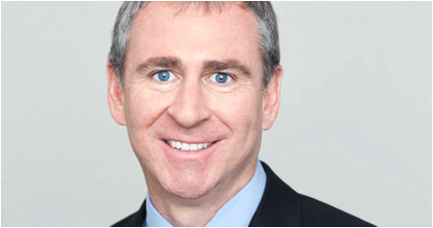
- Griffin once paid $500 million for just two paintings.[13]
- He also recently spent $200 million for a three-full-floor, 18,000 square foot condo in midtown Manhattan and $60 million for a Miami penthouse.[14][15]
- Griffin has played a major role in rallying Chicago’s wealthiest donors around Governor Bruce Rauner and his anti-worker, austerity agenda. Griffin and his family members have also contributed $13.6 million to Rauner.[16]
- Griffin is a major donor to conservative causes – he has given millions more to other conservative politicians and PACs, including the Koch brothers.[17][18]
MICHAEL SACKS
Chairman and CEO, Grosvenor Capital Management
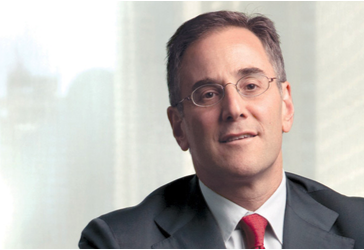
- Grosvenor manages $55 billion in assets, often investing in other hedge funds and private equity firms.[19]
- Sacks is a close friend and confidant of Mayor Rahm Emanuel and a member of his economic council.[20] He has also contributed nearly $3 million to Rahm’s two mayoral elections.[21]
- As if that weren’t enough, he is also friends with the governor, and his wife Cari sits on the board of Diana Rauner’s Ounce of Prevention Fund. Sacks reportedly has “cache” with the governor and has been a key liaison between Rauner and Rahm.
- Sacks is also a major figure in the Democratic Party nationally: he is a board member and million-dollar-donor to the Obama Foundation, which might have something to do with why his daughter got a coveted White House internship.[22][23]
- And yet, Sacks also has a contact at the Trump White House: Grosvenor managing director Jeremy Katz left the firm to become deputy director of the National Economic Council and deputy assistant to Trump.[24]
BRUCE RAUNER
Governor of Illinois
Formerly chairman of GTCR
Net worth: $500 million
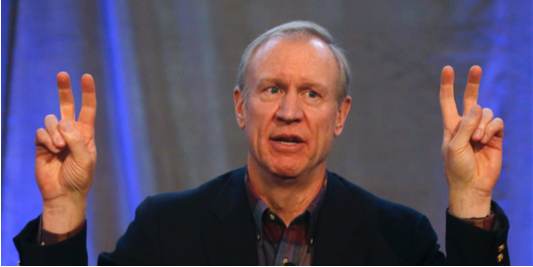
- Rauner purchased the governorship of Illinois with millions in donations from a few hedge fund tycoons — and millions of his own wealth.[25]
- One reason he had all that extra cash sloshing around: Rauner dodged paying millions in taxes by taking advantage of the carried interest loophole on income he received as a private equity firm executive.[26]
- He once told Chicago elites that half of the city’s public school teachers were “virtually illiterate.”[27]
- Rauner recently attended the Koch donor summit in California.[28]
- He also supports making Illinois a right-to-work state and vetoed aid to Illinois state university and community college students.[29]
SAM ZELL
Founder and Chairman, Equity Group Investments
Net worth of $4.9 billion
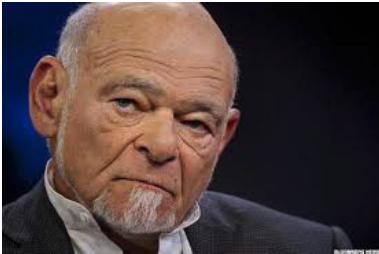
- Zell is a major real estate investor, but also invests in other industries, such as oil refining.
- In 2014, Zell said that “the 1% work harder” and that people “should not talk about envy of the 1%, they should talk about emulating the 1%”.[30]
- Zell took to CNBC to defend the carried interest loophole in 2014. The only real defense he could muster: closing it would hurt his firm’s bottom line and cost him money. Floundering at the end of the interview, he said to his interviewer, “Now, you’re a journalist, so maybe you don’t understand the math involved.”[31]
- Zell owns a manufactured home property company, Equity Lifestyle, that has attacked rent control laws so that it can hike rents on its tenants.[32] The company has generated record returns for shareholders in recent years – 27% in 2015.[33]
- He calls himself the Grave Dancer for his success in profiting off of distressed assets.
- Zell gave $4 million to Bruce Rauner’s Super PAC, Turnaround Illinois.[34]
JOHN CANNING, JR.
Co-founder and chairman, Madison Dearborn Partners

- Under Canning’s leadership, Madison Dearborn purchased VWR, a laboratory supply company, in 2007 and continues to control the company.[35] A 2012 In These Times article paints a disturbing picture of how the company has operated under Madison Dearborn’s control:
A California-based company called VWR is busting its union, moving work to a non-union workforce a few hours away and receiving both federal and state tax incentives to do it. The scandal is yet another example of how companies can game the tax systems while hurting workers, and the government does little to stop them.
- He is a major donor to Rahm Emanuel, whom he first developed a relationship with after Emanuel left the Clinton White House. Madison Dearborn became a top contributor to Emanuel during his time in Congress.[36]
- When Congress considered closing the carried interest loophole in 2007, Madison Dearborn hosted Rahm Emanuel for a luncheon so that he could hear their perspective on it (Rahm did end up voting to close the loophole, though the bill ultimately failed).[37]
- Canning is also a major Republican donor, giving hundreds of thousands of dollars each year to Republican politicians and PACs on the federal level.[38]
- Canning owns a massive 13-bedroom, 12-bath vacation home in Wisconsin that was formerly a hotel.[39] Of South Africa’s luxury Blue Train, he once said “You can dress for dinner, smoke cigars. It’s like Downton Abbey. I loved it.”[40]
DMITRY BALYASNY
Founder, Balyasny Asset Management

- Balyasny is a major donor to the Ayn Rand Institute and a board member of its Chicago chapter.[41][42]
- In 2009, Balyasny hired a team of traders to help his firm profit from changes in healthcare laws.[43] The next year, his firm came under investigation for insider trading.[44]
- Among his firm’s top investments is Olin Corp, a manufacturer of ammunition that has major federal contracts. Balyasny’s investment in the company is nearly $200 million.[45]
- Even after SAC Capital Advisors pled guilty for security fraud and insider trading, Balyasny had no qualms hiring traders who were employed at the notorious hedge fund while it was committing its crimes.[46]
- One of Balyasny’s former employees in Europe sued Balyasny Asset Management for its “unrelenting” homophobia.[47]
HEDGE FUNDS RIG THE SYSTEM IN WASHINGTON, DC TO KEEP THEIR TAX BREAK
Congress won’t act – because hedge funds and private equity firms are using millions of dollars in lobbying and campaign cash to keep the loophole open.
Congress won’t act – because hedge funds and private equity firms are using millions of dollars in lobbying and campaign cash to keep the loophole open. Share on XHedge funds and banks have spent millions of dollars in campaign cash and lobbying to protect their loopholes and special treatment, blocking action in Congress.[48]
In last year’s elections, hedge fund and private equity managers were top givers to Senate Majority Leader Mitch McConnell, House Speaker Paul Ryan, and to leadership PACs and related Super PACs that kept Congress in the hands of conservative Republicans who have protected the carried interest loophole.
Tax bills originate in the House of Representatives. Hedge fund billionaires have taken care of themselves by taking care of top leadership there.

House Speaker Ryan is the number-one recipient of hedge fund and private equity donations in the House, and a hedge fund billionaire is his number-one donor.[49]
Ken Griffin and fellow hedge fund billionaires Paul Singer, Cliff Asness, Julian Robertson, Dan Loeb, Stanley Druckenmiller, Leon Black and multimillionaire Thomas McInerney are all in the top 25 donors to the Paul Ryan Super PAC “Congressional Leadership Fund,” giving a total of $5,217,000.[50]
And the money flows on the Senate side as well – bigly.
Hedge fund and private equity billionaires Singer, Griffin, Asness and Stephen Schwarzman were among the top givers to McConnell’s PACs and Super PACs giving an astounding total of $8,479,425: eight-and-a-half million dollars, just from the four of them.[51]

But fund managers are playing a long game to keep their tax breaks.
Hedge fund and private equity lobbying and political spending increased dramatically in 2007 — the same year Congress took steps to close the carried interest loophole.
That effort failed, as have subsequent efforts, due to a torrent of lobbying and campaign cash. Lobbying spending by the hedge fund and private equity industries soared 455% in 2007, from $4.1 million in 2006 to over $23 million in 2007. It has never dropped back to pre-2007 levels.[52][53]
Since 2007, the two industries have spent a combined average of $20 million per year on lobbying. By comparison, total lobbying spending from 2000 to 2006 was a mere $17.2 million ($2.5 million per year), less than the single year average since.
Industry associations have played a major role in this effort.

The Managed Funds Association, the hedge fund industry lobby, increased its lobbying spending five- fold in 2007, from $340,000 to $1.9 million.[54] The MFA has maintained this lobbying increase and spent over $4 million in 2015.
The private equity lobby, the Private Equity Growth Capital Council, was first established in 2007. It hit the ground running, spending $2.5 million on lobbying in its first year and over $20 million since.[55]
And New York billionaires are leading members of both groups.
Campaign finance records show that their lobbying spending spree was coupled with an increase in campaign donations.
In 2007 and 2008, hedge funds and private equity firms increased their political giving by over three times, from $7.3 million in the 2006 cycle to $24.5 million in the 2008 cycle. In each election cycle since 2008, hedge funds and private equity have donated an average of $7.7 million and $15 million respectively.[56]
STATE-LEVEL ACTION TO CLOSE THE CARRIED INTEREST LOOPHOLE
Illinois and other states can gain billions of dollars in new revenue by taking action where Congress won’t – by closing the carried interest loophole.
State legislatures should pass legislation to “repatriate” revenue lost to the federal-level loophole. We can tax the carried interest income of hedge fund and private equity partnerships headquartered in each state and bring the money home for investment in schools, housing, jobs and clean-energy infrastructure.

A CLOSER LOOK AT THE NUMBERS: METHODOLOGY FOR PREPARING THE TAX ESTIMATION
Datasets of all fund registered investment advisors were obtained from the SEC’s public database. This data was enriched with ADV Part 7(b) data, which contains private funds and their AUM.
Illinois headquartered registered investment advisors were cross-referenced to the funds they manage by SEC file number. Combined, these funds had gross assets under management of $680.5bn and $116.2bn, respectively.
To estimate total earnings, we used private equity and hedge fund return benchmarks for a five-year period.
One uses the five-year average of leading hedge fund and private equity benchmarks, assuming that the large state sample sizes roughly track the mean. For hedge funds, we used the HFRI Fund Weighted Composite’s 60-month average.[57] For private equity, we used the Cambridge Associates U.S. Private Equity Index five-year end-to-end pooled return.[58] By multiplying the return benchmarks by the AUM, we came up with a rough estimation of expected annual earnings.
Next, the carried interest apportioned to hedge fund and private equity managers is estimated.
Carried interest applies only to the incentive fee earned by hedge fund and private equity managers.
We used 15% of the total of hedge fund and private equity expected annual earnings to arrive at the expected aggregated fund manager annual earnings. We went with 15% because we believe this number to be extremely conservative.
With hedge funds, 20% is the industry standard and 17.14% was the industry average for new funds launched in 2013, as tracked by Preqin.[59] In private equity, the 20% standard is prevalent in 85% of co-mingled funds, according to a 2015 report by Preqin.[60] Separate accounts, where approximately one-third of investor capital was committed in late 2014,[61] are less likely to charge a 20% carry, although 90% charge 10% or more.[62]
To calculate the amount lost to carried interest exemptions, we halved the expected aggregate fund manager annual earnings.
This was done to reflect the individual reporting of taxes paid on partnerships interest in financial service partnerships. As Professor Victor Fleisher discovered in his work on the subject, the IRS Statistics of Income shows that roughly half of financial industry partnership income is paid at the favorable carried interest rate.[63][64]
After halving this sum, we multiplied the remaining amount by 19.6%, the difference between the top bracket for short-term capital gains (equivalent to ordinary income, at 39.6%) and the top bracket for long-term capital gains (20%).

Footnotes
[1] http://www.usatoday.com/story/opinion/2015/09/15/hedge-fund-carried-interest-donald-trump-jeb-bush-editorials-debates/72268922/
[2] http://billmoyers.com/2015/09/17/why-do-kindergarten-teachers-pay-more-taxes-than-hedge-fund-managers/
[3] http://www.usatoday.com/story/opinion/2015/09/15/hedge-fund-carried-interest-donald-trump-jeb-bush-editorials-debates/72268922/
[4] https://www.nytimes.com/2015/06/06/business/dealbook/how-a-carried-interest-tax-could-raise-180-billion.html?_r=0
[5] http://hedgeclippers.org/hedgepapers-no-38-hedge-fund-billionaires-attack-the-hudson-valley/
[6] https://www.bloomberg.com/news/articles/2017-01-19/with-close-trump-ties-private-equity-eyes-tax-financial-reform
[7] https://mobile.nytimes.com/2016/03/11/opinion/new-york-challenges-a-tax-privilege-of-the-rich.html?_r=0
[8] https://fas.org/sgp/crs/misc/RS22689.pdf
[9] http://www.taxpolicycenter.org/briefing-book/key-elements/business/carried-interest.cfm
[10] Plus a 3.8% Medicare surtax
[11] https://www.nytimes.com/2015/06/06/business/dealbook/how-a-carried-interest-tax-could-raise-180-billion.html?_r=0
[12] https://www.forbes.com/profile/ken-griffin/
[13] https://www.bloomberg.com/news/articles/2016-02-18/billionaire-griffin-said-to-pay-500-million-for-two-paintings
[14] http://www.vanityfair.com/news/2016/02/billionaire-hedge-funder-ken-griffin-continues-to-live-his-best-life
[15] https://www.nytimes.com/2015/10/04/business/kenneth-griffin-goes-on-a-record-setting-real-estate-spending-spree.html?_r=0
[16] https://www.nytimes.com/2015/11/30/us/politics/illinois-campaign-money-bruce-rauner.html
[17] https://www.opensecrets.org/search?q=ken+gri
[18] http://www.businessinsider.com/ken-griffin-charles-schwab-and-paul-singer-are-all-members-of-koch-brothers-million-dollar-donor club-2011-9
[19] http://www.chicagomag.com/Chicago-Magazine/March-2016/Power-50/Michael-Sacks/
[20] http://www.chicagomag.com/Chicago-Magazine/September-2016/Michael-Sacks-Is-the-Rahm-Whisperer/
[21] http://www.chicagomag.com/Chicago-Magazine/March-2016/Power-50/Michael-Sacks/
[22] https://www.obama.org/whats-next/leadership/the-board/
[23] http://www.chicagotribune.com/news/local/politics/ct-obama-donor-daughter-wh-intern-met-20150626-story.html
[24] http://chicago.suntimes.com/politics/sneed-chicago-fiscal-wizard-joins-trump-team/
[25] https://www.nytimes.com/2015/11/30/us/politics/illinois-campaign-money-bruce-rauner.html
[26] http://www.nbcchicago.com/blogs/ward-room/Bruce-Rauner-tax-returns-fee-waiver-loophole-GTCR-Pat-Quinn-Illinois-governor-265573091.html
[27] http://www.chicagotribune.com/news/local/politics/ct-bruce-rauner-cps-teachers-met-0722-20160721-story.html
[28] http://www.nbcchicago.com/news/local/illinois-governor-bruce-rauner-trump-executive-order-412090203.html
[29] http://www.nbcchicago.com/blogs/ward-room/Rauner-Vetoes-Map-Grant-Bill-369469972.html
[30] https://www.bloomberg.com/news/videos/b/75f58b37-90f1-42f0-86c1-014aeb39a3e9
[31] http://www.cnbc.com/2014/04/08/sam-zell-why-fund-managers-need-low-taxes.html
[32] http://abc7news.com/archive/6104060/
[33] http://www.chicagobusiness.com/article/20160213/ISSUE01/302139989/this-is-chicagos-best-performing-reit
[34] https://www.nytimes.com/2015/11/30/us/politics/illinois-campaign-money-bruce-rauner.html
[35] http://investors.vwr.com/releasedetail.cfm?releaseid=251953
[36] http://www.nytimes.com/2008/12/04/us/politics/04emanuel.html
[37] http://www.nytimes.com/2008/12/04/us/politics/04emanuel.html
[38] https://littlesis.org/person/42670/John_Canning_Jr/political
[39] http://www.chicagobusiness.com/article/20140703/BLOGS03/140709926/ghostly-getaway-the-cannings-celebrate-july-4-in-their-haunted
[40] http://www.chicagobusiness.com/article/20130330/ISSUE09/303309960/john-canning-jr-on-why-baseball-is-all
[41] https://www.insidephilanthropy.com/home/2016/8/3/if-altruism-is-overrated-whos-backing-ayn-rands-ideas.html
[42] https://www.bamfunds.com/guest/ab_bam_leaders_db.html
[43] http://blogs.wsj.com/deals/2010/11/23/meet-the-new-hedge-fund-in-the-insider-trading-probe-balyasny/
[44] http://blogs.wsj.com/deals/2010/11/23/meet-the-new-hedge-fund-in-the-insider-trading-probe-balyasny/
[46] https://dealbook.nytimes.com/2014/02/26/a-hedge-fund-manager-says-sac-taint-is-manageable/
[47] http://www.businessinsider.com/gay-asset-manager-suing-london-hedge-fund-after-homophobic-abuse-2016-11
[48] http://thehill.com/blogs/congress-blog/economy-budget/257083-what-the-carried-interest-tax-loophole-reveals-about-our
[49] https://www.opensecrets.org/politicians/industries.php?cycle=2016&cid=N00004357&type=C&newmem=N
[50] https://www.opensecrets.org/outsidespending/contrib.php?cmte=C00504530&cycle=2016
[51] http://www.jsonline.com/story/news/politics/mitch-mcconnell/2016/10/24/updated-list-mcconnells-biggest-donors/92667300/
[52] https://www.opensecrets.org/industries/lobbying.php?cycle=2016&ind=f2700
[53] https://www.opensecrets.org/industries/lobbying.php?ind=F2600
[54] http://hedgeclippers.org/hedgepapers-no-14-the-gift-of-greed-how-hedgefund-philanthropists-increase-inequality/
[55] https://www.opensecrets.org/lobby/clientsum.php?id=D000036835&year=2007
[56] https://www.opensecrets.org/industries/summary.php?ind=f2700&recipdetail=A&sortorder=U&mem=Y&cycle=2014
[57] https://www.hedgefundresearch.com/mon_register/index.php?fuse=login_bd&1448033777
[58] http://www.cambridgeassociates.com/wp-content/uploads/2015/05/Public-USPE-Benchmark-2014-Q4.pdf
[59] https://www.preqin.com/blog/0/8340/hedge-funds-fees
[60] https://www.preqin.com/docs/press/Fund-Terms-Sep-15.pdf
[61] http://www.pionline.com/article/20141222/PRINT/312229973/assets-invested-in-separate-accounts-starting-to-add-up
[62] http://www.valuewalk.com/2015/09/48-of-private-equity-separate-accounts-charge-a-20-performance-fee/
[63] 56% of the income generated by finance and insurance partnerships in 2012 was taxed at this rate.
[64] https://www.nytimes.com/2015/06/06/business/dealbook/how-a-carried-interest-tax-could-raise-180-billion.html?_r=0


